Don’t worry about not having an outdoor garden. You garden indoors, and plants give you the peace of sight and mind you need INSIDE your own house! Gardening isn’t something that is limited by space (You don’t need to be a landlord to be able to garden!).
Indoor gardening for beginners is something which is fun and daunting at the same time. But don’t you worry! We got you!
If you’re looking for house gardening tips, you’ve come to the RIGHT place.
With years of experience in our hands, we make it easier for you. Our expertise make your indoor space look like a picture out of HEAVEN! There are so many plants to choose from and so many techniques that you could employ. Providing you the indoor gardening tips and tricks of the trade.
Here, you get to know about ALL of them!
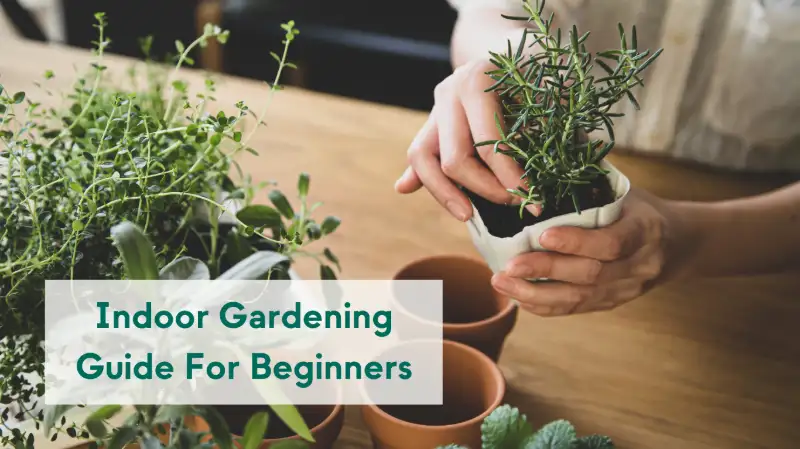
What is Indoor Gardening?
Plants need to be all around us all the time. It makes sense to grow more plants indoors since they purify the air around them.
Now, who doesn’t want to BREATHE clean? Not to mention they do wonders with the indoor environment that you want to create in your house. (YOU could be the talk of the town)
There are some specific types of plants you’d want to grow indoors, though. We cover all of them in this article and have you well-equipped to start your indoor garden.
WHISPERs excitedly: You can even grow your herbs indoors!
What are the Pre-requisites to Start Indoor Gardening for Beginners?
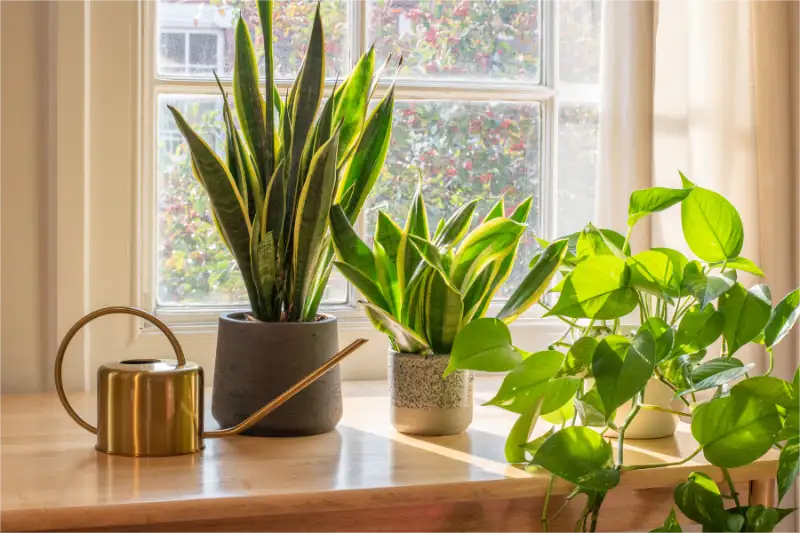
A simple pre-requisite is to be interested in indoor gardening. Once you’ve made that decision, let your imagination run WILD. And of course, be with us in your indoor gardening journey.
- Space Lighting.
You already know the secret to how plants get their energy from. THE SUN! Well, when you’re growing plants indoors, you won’t have sunlight now, would you? The answer isn’t yes, or no.
It depends on what kind of space you have. You have to choose plants that are compatible with your living space and THRIVE indoors.
For some plants, natural sunlight is a must. Others can function well in artificial lighting.
There are, of course, various options for indoor plants which grow well in the shade. But the point is that you have to consider WHICH plant will grow in WHAT environment.
- Room Temperature
Your plant may be SASHA FIERCE as Beyonce or as COOL as MCJAGGER. So you better know what temperatures the plant you want to grow indoors is best suited for. As a rule of thumb, most plants indoors grow best between 60 – 75°F (15 – 24°).
- Type of Plant
Of course, you want to have ALL the plants, you crazy indoor gardener. But you have to know where the plant looks best aesthetically. There are climbers whose vines grow vertically.
Now you hang them somewhere and have the vines fall, or tie a rope and let it grow upwards.
There are various options. From succulents that occupy less space to a Madagascar dragon tree that grows tall. PROBABLY the dragon takes the area of a whole sofa.
So choosing the right type of plant is something you have to identify.
- Drainage
We have our washrooms, well SURPRISE, the plants also need their own drainage. But this isn’t true for all plants. Later we’ll also tell you about a plant that grows without soil, JUST in water.
But drainage holes are an essential factor when planning indoor gardens.
Common Types of Indoor Gardening Techniques
Your indoor Garden can be done in many ways. On the walls, on the window sills, and, of course, on the floor. Just make sure not to get too excited and leave some space for yourself too!
Indoor gardeners tend to get SUPER hyped about their plants. Let’s break them down one by one, shall we?
Container Gardening

This is the MOST common form of gardening. It’s very CONVENIENT as pots, containers, or gardening bags are readily available.
You’ll love experimenting with different containers as well. Each room can have it’s own potted plant containers to enhance the room’s aesthetic appeal.
Living Walls
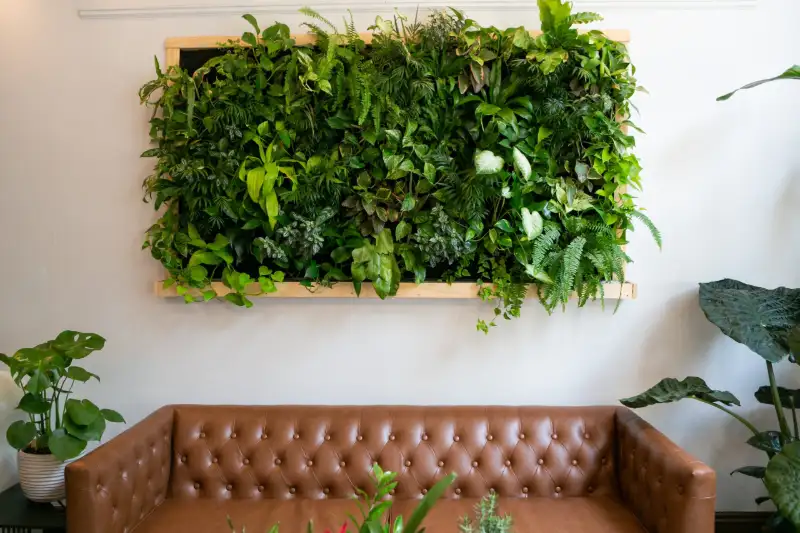
You use a wall in your house to hang pots or create embedded planters. There are just too many options. Let’s show you some of them so you visualize what’s going on.
You directly hang these plants up on the wall with their pots. When you do, the plants do not need too frequent watering since drainage is a problem in this method.
Didn’t we talk about drooping vines? Well, they look fabulous, don’t they
This is a style to seriously consider if you’re interested in growing indoors. The drooping vine gives a calming sensation.
Even the wall rack on the side looks good enough to want to start gardening.
Vertical Gardening
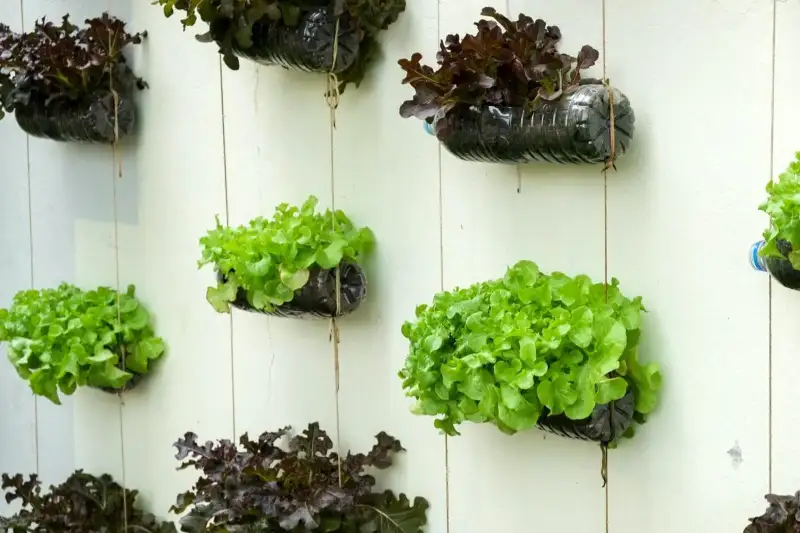
Space is an issue indoors; that’s why we want YOU to make the MOST of it! You can stack the plants if you get a rack. This also means your indoor Garden will have ALOT of fellow plants for company.
Racks like these save you a lot of space. You put a cluster of different plants or set them in rows. Anything you do with frames like these looks beautiful. Plants on the top most shelf might even get more direct light throughout the day. That’s something to keep in mind.
Indoor Gardening Tricks Every Gardener Should Know

Indoor plants require a different form of care and effort. (No, giving them company isn’t just enough to help them grow). Let us show you the ULTIMATE tips and tricks of indoor gardening.
Less H20
No, we’re not trying to be cruel to the plant. When growing a plant indoors, the water from the pot doesn’t evaporate as fast. This means the plant has plenty of water to drink over the day or for some days. This is just basic mechanics.
Now only treat some plants like a cactus. Be sure to check if it needs more water or not. More often than not, indoor plants die because of over-watering. But you still need to water your plants regularly.
So the TRICK is: Put your finger in the pot. If the soil is dry even 2 inches beneath the surface, it’s water time.
Pruning
Everyone feels sad when they see a yellow leaf or stem amongst all your healthy leaves and stems. It makes you unhappy. Well, it makes the plant sad as well. (It’s just not nutritional, darling).
So cut off any old wilted parts as it isn’t healthy for the plant to stick on them. This promotes a healthy growing environment for the plant.
Soil
You want cozy soil for your plant, just like your own bed. Lightweight organic potting soil which is fluffy and drains well. That’s the soil for indoor plants, especially with a drainage hole.
Medium-weight soil would be just too heavy for pots to hang. So choose the ground according to your plant arrangement.
Organic Fertlizer
You have to give the plant its form of RedBull now. You can’t function without coffee in the morning. What makes you think this plant will FULLY perform without its coffee?
A nourishing growing medium is a must for plants. It’s healthy to give indoor plants a small dose of organic fertilizer. This boost of nutrients helps your plants stay healthy even indoors.
Cleanliness
Plants naturally get cleaned outside because of rain. But Indoor, you have to give them their shower. From time to time, their leaves will get dusty. You can’t have their factories which make plant food covered up in dust, now can you? That isn’t good for plant growth.
You either use a spray bottle and mist the leaves every day. Still, you need to clean the plant like a piece of furniture at least once a week.
Repotting is Healthy
Repotting can sometimes mean changing the pot. It’s no hard and fast rule that you must do this, but sometimes it’s necessary. After a couple of months, it’s healthy to change the soil in your plants.
Changing the soil in your plants will refresh their nutrients, and it’s great for plant growth. This doesn’t mean that you ultimately got rid of it. Instead, you take some out and put some new back in.
What Plants are Best to Grow for An Indoor Garden?
When you’re thinking of keeping plants inside, you don’t want delicate plants. They would require too much of your attention. (That’s just toxic, not with plants, though). We show you some plants to start with.
Aglaonema

Aglaonema is low-maintenance and the right plant for beginners. The popular houseplant comes in many different COLORS. You get more of these in different shades rather than thinking of getting other plants.
Get this plant excellent potting soil and some indirect sunlight, and it’ll flourish.
Here’s a tip: Try mixing perlite into your potting soil mix. It’ll do wonders for the plant’s growth.
Heartleaf Philodendron

We told you we’d tell you a plant that grows in water. Well, HERE it is. The heartleaf plant can grow in direct water. There is a little effort that you have to make. Either get a plant that is grown in water or one from the ground and covert it. (No, not religiously)
Convert a Heartleaf to being grown in water. Take a long cutting with at least one or two leaf nodes submerged in the water. This will help the plant to develop enough roots to thrive in the aquatic environment.
Mint
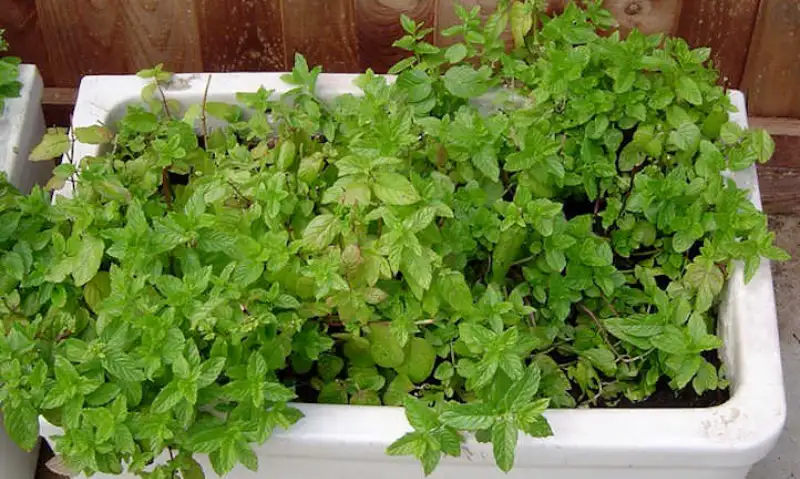
You got it right! You also grow herbs and make your indoor herb garden! Now, who isn’t a fan of fresh herbs? They give a lovely scent. How much light does this plant need, you ask?
Well, like all of these indoor plants, not much.
It’s always fun growing herbs as these salad greens are organic matter growing INFRONT of you. Mint grows fast, so you better start chugging on those margaritas!
Swiss Cheese Plant

The Swiss cheese plant is named for the LARGE, perforated leaves that resemble. The Swiss cheese plant is a popular indoor plant. They thrive in well-draining soil and bright, indirect light.
It is known for its ability to adapt to a wide range of conditions and is relatively low maintenance.
When cared for properly, the Swiss cheese plant can grow quite large. Their leaves reach up to three feet in length. It is a popular choice for indoor spaces due to its lush, tropical appearance and ability to purify the air.
The Swiss cheese plant is for plant lovers everywhere. Its distinctive leaves and easy care requirements make it popular.
Essential Tools Every Beginner Needs for Indoor Garden
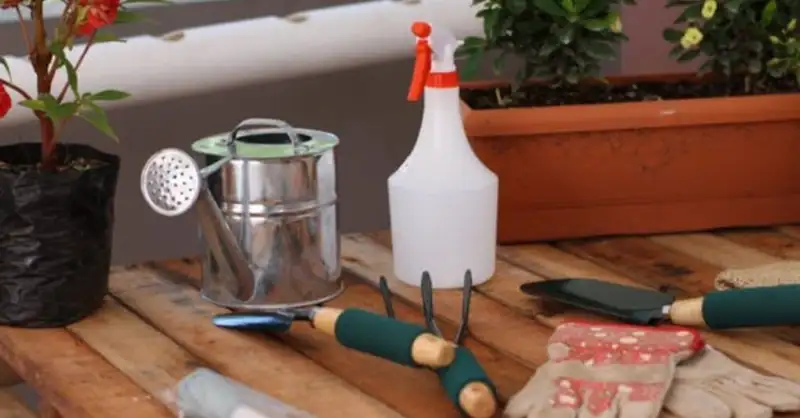
There are a few items that are essential for your indoor gardening kit. (Yes, we have tools for indoor gardening, we aren’t cave people)
Pruners
Poor quality or weak-bladed pruners can result in crushed and torn stems. When snipping off foliage, leaves the plant vulnerable to bug infestations and diseases.
Invest in a high-quality pruning tool and keep the blades sharp. This ensures clean cuts and healthy plants.
Moisture Meter
Over-watering is a common problem in indoor plants. The frequency and format of watering plants in outdoor and indoor spaces differ. This helps you monitor precisely that.
Spades
Gardening spades are tools for digging, planting, and cultivating soil. They have a flat, shovel-like blade that is used to scoop and turn the soil and a handle for gripping.
They are an essential tool for any gardener. They are used for a wide range of tasks. These include:
- preparing soil for planting (this improves the growing medium),
- planting seeds and seedlings
- removing weeds.
FAQs about Indoor Gardening For Beginners
1. Is indoor gardening hard for beginners?
Indoor gardening is the best way to step into gardening. You’ll enjoy the plant in front of you by yourself and treat it like your own baby!
2. What is the most low-maintenance indoor plant?
Succulents are low-maintenance plants. Aloe Vera, to be specific, quickly grow indoors and has much utility too.
3. What is the most popular indoor plant?
The most popular indoor plant is the money plant. It’s SUPER EASY to grow, it thrives even in winter months.
4. How can you grow vegetables indoors without sunlight?
Consider making an indoor vegetable garden to fresh produce your food. And the answer is YES, you can. Some vegetables can grow indoors without sunlight, e.g., cherry tomatoes. All you need to do is provide the right conditions and probably get some led grow lights.
What’s Next
Your indoors is your sanctuary and should reflect a version of you. If you let this act as your guide to indoor gardening, you will learn a lot, and you’ll have fun doing it. As you get the hang of gardening, you’ll love seeing what more we offer.
There are numerous informative articles on our website, which can be very useful for you.
Even your friends who have/ want green thumbs. Make sure to SHARE this knowledge with them and have FUN.
